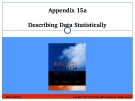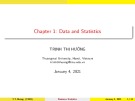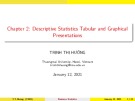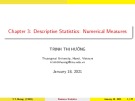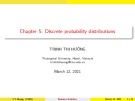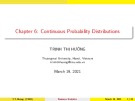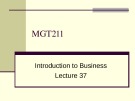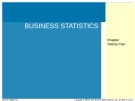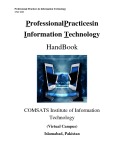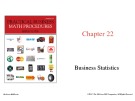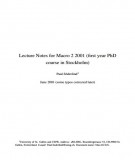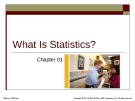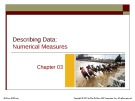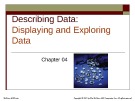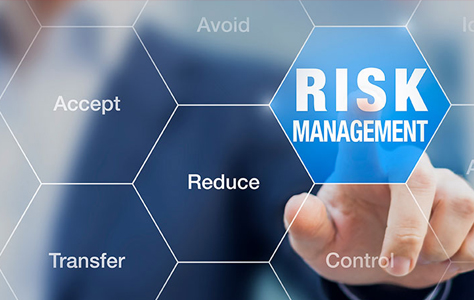
Lecture Business statistics
-
Lecture Business research methods (12/e) - Chapter 16: Exploring, displaying, and examining data. After studying this chapter you will be able to understand: That exploratory data analysis techniques provide insights and data diagnostics by emphasizing visual representations of the data; how cross-tabulation is used to examine relationships involving categorical variables, serves as a framework for later statistical testing, and makes an efficient tool for data visualization and later decision-making.
 41p
41p  haojiubujain04
haojiubujain04
 27-07-2023
27-07-2023
 7
7
 6
6
 Download
Download
-
Lecture Business research methods (12/e) - Appendix 15A: Describing data statistically. This chapter presents the steps necessary to prepare data for data analysis. This chapter presents the following content: Frequencies, distributions, characteristics of distributions, measures of central tendency,...
 12p
12p  haojiubujain04
haojiubujain04
 27-07-2023
27-07-2023
 9
9
 5
5
 Download
Download
-
Lecture Business research methods (12/e) - Chapter 17: Hypothesis testing. After studying this chapter you will be able to understand: The nature and logic of hypothesis testing, a statistically significant difference, the six-step hypothesis testing procedure, the differences between parametric and nonparametric tests and when to use each, the factors that influence the selection of an appropriate test of statistical significance, how to interpret the various test statistics.
 67p
67p  haojiubujain04
haojiubujain04
 27-07-2023
27-07-2023
 4
4
 4
4
 Download
Download
-
Lecture Business statistics - Chapter 1: Data and statistics. The main topics covered in this chapter include: statistics in practice; applications in business and economics; data; data sources; descriptive statistics; statistical inference; computers and statistical analysis;... Please refer to the lecture for details!
 14p
14p  chutieubang
chutieubang
 06-12-2022
06-12-2022
 12
12
 3
3
 Download
Download
-
Lecture Business statistics - Chapter 2: Descriptive statistics tabular and graphical presentations. The main topics covered in this chapter include: statistics in practice; summarizing qualitative data; summarizing quantitative data; cross-tabulations and scatter diagrams;... Please refer to the lecture for details!
 12p
12p  chutieubang
chutieubang
 06-12-2022
06-12-2022
 10
10
 3
3
 Download
Download
-
Lecture Business statistics - Chapter 3: Descriptive statistics - Numerical measures. The main topics covered in this chapter include: measures of location; measures of variability; measures of distributional shape, relative location and detecting outliers; exploratory data analysis; measures of association between two variables;... Please refer to the lecture for details!
 27p
27p  chutieubang
chutieubang
 06-12-2022
06-12-2022
 13
13
 2
2
 Download
Download
-
Lecture Business statistics - Chapter 4: Introduction to probability. The main topics covered in this chapter include: statistics in practice; experiments, event and their probabilities; some basic relationships of probability;... Please refer to the lecture for details!
 12p
12p  chutieubang
chutieubang
 06-12-2022
06-12-2022
 10
10
 2
2
 Download
Download
-
Lecture Business statistics - Chapter 5: Discrete probability distributions. The main topics covered in this chapter include: statistics in practice; random variables; discrete probability distributions; expected value and variance; binomial probability distribution;... Please refer to the lecture for details!
 13p
13p  chutieubang
chutieubang
 06-12-2022
06-12-2022
 7
7
 2
2
 Download
Download
-
Lecture Business statistics - Chapter 6: Continuous probability distributions. The main topics covered in this chapter include: uniform probability distribution; mean and variance of uniform probability distribution; normal probability distribution; standard normal probability distribution;... Please refer to the lecture for details!
 15p
15p  chutieubang
chutieubang
 06-12-2022
06-12-2022
 19
19
 2
2
 Download
Download
-
Lecture Introduction to Business: Lesson 37. The main topics covered in this lesson include: total quality management, quality control system, quality assurance system, prominent features of dr. demming’s 14 points, human resource management for total quality management, statistical process control,...
 14p
14p  alucardhellsing
alucardhellsing
 30-04-2022
30-04-2022
 16
16
 1
1
 Download
Download
-
After studying this chapter you will be able to: define and calculate the mean, explain and calculate a weighted mean, define and calculate the median, define and identify the mode, prepare a frequency distribution, prepare bar, line, and circle graphs, calculate price relatives and cost comparisons, explain and calculate the range, define and calculate the standard deviation, estimate percentage of data by using standard deviations.
 18p
18p  koxih_kothogmih10
koxih_kothogmih10
 26-10-2020
26-10-2020
 14
14
 1
1
 Download
Download
-
After studying this chapter you will be able to understand: What a market basket is and why it’s important? How to calculate and use a price index? How to identify challenges the Bureau of Labor Statistics (BLS) faces when measuring inflation? How the BLS responds to these challenges?...
 31p
31p  nanhankhuoctai1
nanhankhuoctai1
 06-05-2020
06-05-2020
 9
9
 1
1
 Download
Download
-
Lecture 23 - Plagiarism and referencing. After studying this chapter you will be able to understand: What is plagiarism? Examples of plagiarism, terminology: copyright, legal implications, what are the purposes of referencing? What should be referenced?
 4p
4p  tieu_vu17
tieu_vu17
 02-08-2018
02-08-2018
 36
36
 2
2
 Download
Download
-
Chapter 22 - Business statistics. After you have mastered the material in this chapter, you will be able to: Define and calculate the mean, explain and calculate a weighted mean, define and calculate the median, define and identify the mode, prepare a frequency distribution, prepare bar, line, and circle graphs, calculate price relatives and cost comparisons, explain and calculate the range, define and calculate the standard deviation, estimate percentage of data by using standard deviations.
 20p
20p  nomoney9
nomoney9
 04-04-2017
04-04-2017
 48
48
 3
3
 Download
Download
-
Lecture notes in Macroeconomic and financial forecasting include all of the following: Elementary statistics, trends and seasons, forecasting, time series analysis, overview of macroeconomic forecasting, business cycle facts, data quality, survey data and indicators, using financial data in macroeconomic forecasting, macroeconomic models,...
 53p
53p  nomoney7
nomoney7
 04-04-2017
04-04-2017
 36
36
 2
2
 Download
Download
-
Chapter 2 - Describing data: Frequency tables, frequency distributions, and graphic presentation. After completing this unit, you should be able to: Organize qualitative data into a frequency table, present a frequency table as a bar chart or a pie chart, organize quantitative data into a frequency distribution, present a frequency distribution for quantitative data using histograms, frequency polygons, and cumulative frequency polygons.
 15p
15p  whocare_e
whocare_e
 04-10-2016
04-10-2016
 39
39
 2
2
 Download
Download
-
Chapter 1: What is statistics? When you have completed this chapter, you will be able to: List ways that statistics is used, know the differences between descriptive and inferential statistics, understand the differences between a sample and a population, explain the difference between qualitative and quantitative variables, compare the discrete and continuous variables, recognize the levels of measurement in data.
 14p
14p  whocare_e
whocare_e
 04-10-2016
04-10-2016
 51
51
 1
1
 Download
Download
-
The goals of this chapter are: Discuss environmental analysis and two types of market screening, explain market indicators and market factors, describe some statistical techniques for estimating market demand and grouping similar markets, discuss the value to businesspeople of trade missions and trade fairs,…
 23p
23p  hihihaha3
hihihaha3
 12-12-2016
12-12-2016
 46
46
 1
1
 Download
Download
-
Chapter 3 - Describing data: Numerical measures. Learning objectives of this chapter include: Calculate the arithmetic mean, weighted mean, median, mode, and geometric mean; explain the characteristics, uses, advantages, and disadvantages of each measure of location; identify the position of the mean, median, and mode for both symmetric and skewed distributions; compute and interpret the range, mean deviation, variance, and standard deviation
 15p
15p  whocare_e
whocare_e
 04-10-2016
04-10-2016
 49
49
 1
1
 Download
Download
-
Chapter 4 - Describing data: Displaying and exploring data. After studying this chapter you will be able to: Construct and interpret a dot plot, identify and compute measures of position, construct and analyze a box plot, compute and describe the coefficient of skewness, create and interpret a scatter diagram, develop and explain a contingency table.
 15p
15p  whocare_e
whocare_e
 04-10-2016
04-10-2016
 72
72
 1
1
 Download
Download
CHỦ ĐỀ BẠN MUỐN TÌM









